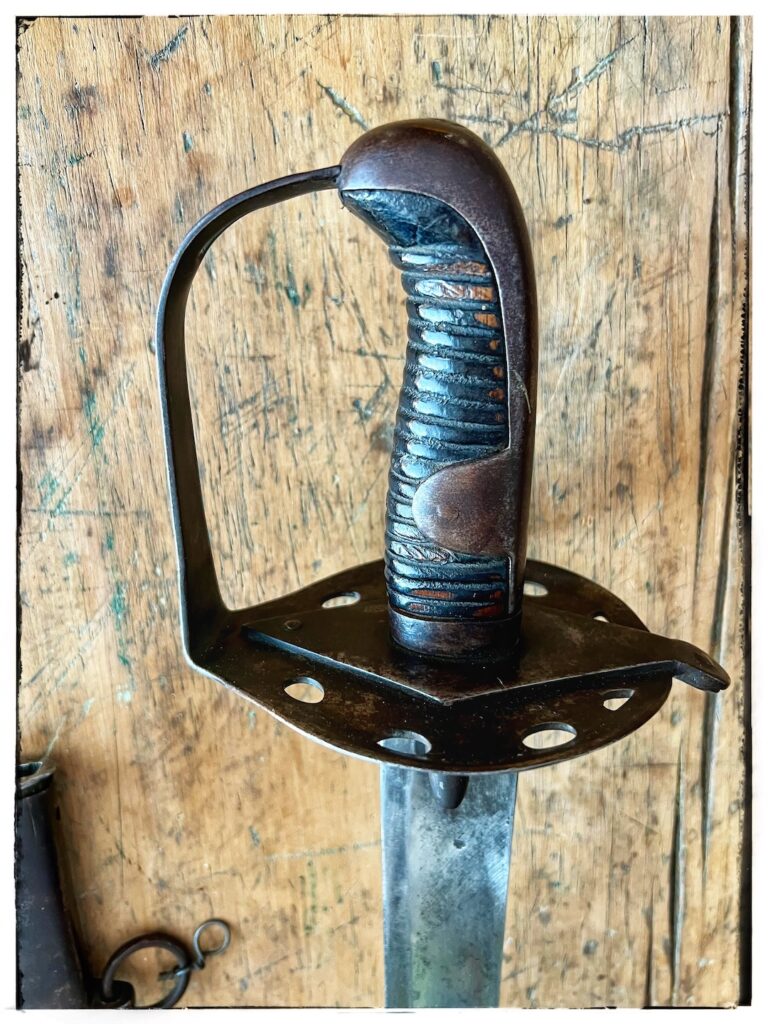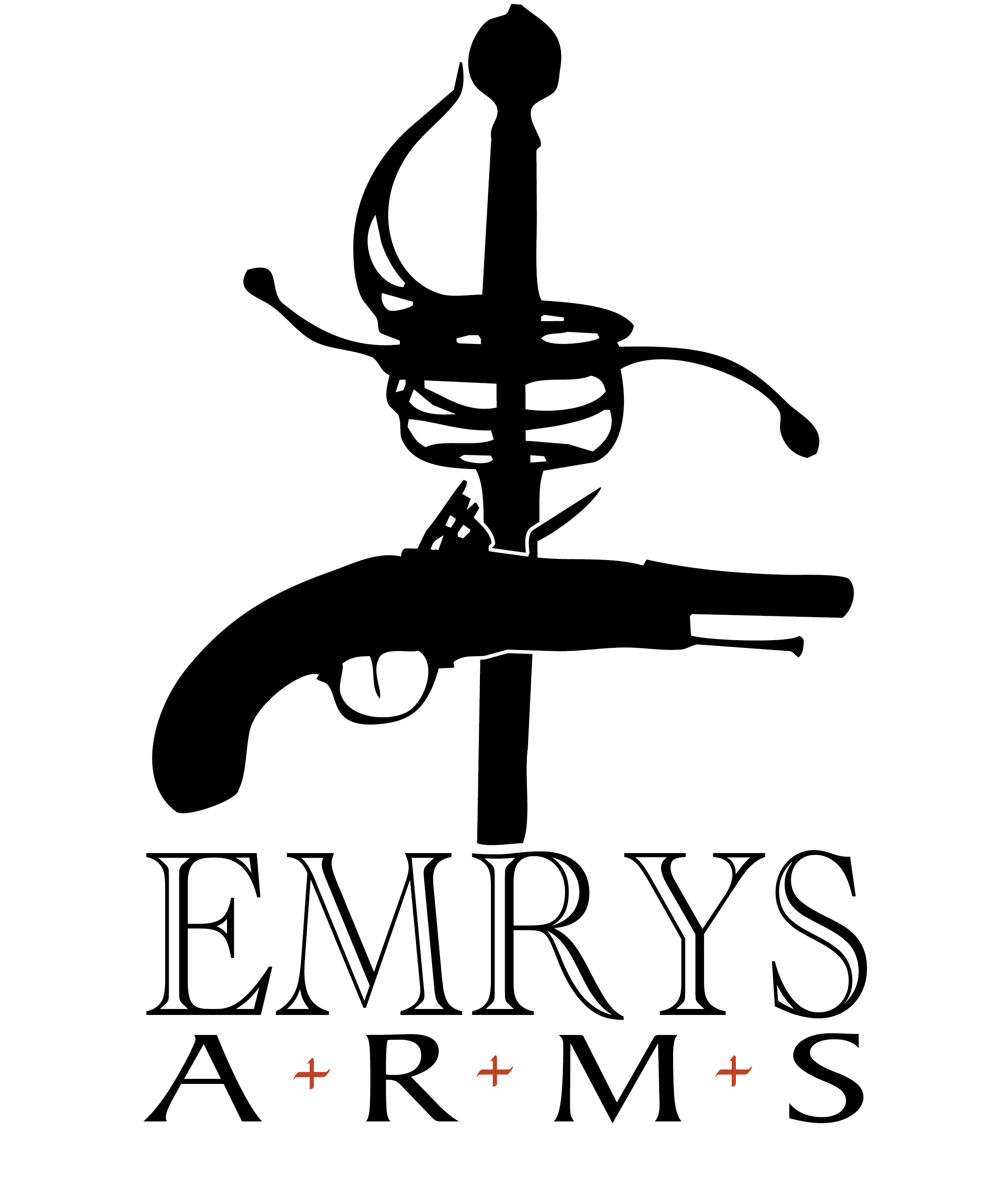| Collection #: | 2020.045 |
|---|---|
| Type: | Backsword |
| Nationality: | British |
| Pattern: | 1796 Pattern |
| Date: | 1796 - 1820ish |
| Hilt: | D guard disc-hilt |
| Blade Length: | 87cm (34.25") |
| Blade Width: | 4cm (1.57") |
| Overall Length: | 104cm (40.94") |
| Maker: | John Gill (1801 - 1817) |
| Blade Markings: | I. Gill on the spine of the blade / B and line balance points on the spine / Crown over 4 inspector's mark |
| Weight: | 1094g (2lbs 6 oz.) sword alone / 1986g (4lbs 6oz.) with scabbard |

This example of the British 1796 Heavy Cavalry Trooper’s sword pattern features a rounded pommel transitioning smoothly into the backstrap, with metal ears riveted through the grooved wooden grip. The D-shaped knucklebow extends into the rounded circular disc guard, which retains its original configuration with no grinding down of the inner side, as was sometimes done for comfort against the hip. The disc guard showcases three oval and one semi-oval piercing on either side of its upturned perimeter.
A diamond-shaped reinforcement plate is securely riveted at the base of the grip, bracing it against the circular guard and the rear quillon at the back of the disc. The grip, made of a grooved wooden core, is firm and intact, with much of its leather covering still present, though worn and hardened with age. Both langets remain intact— they were occasionally removed or lost over time.
Regimental markings on the knucklebow, WYC / K / 29, suggest the sword belonged to the Warwickshire Yeomanry Cavalry, Troop K, sword 29.
The 87 cm-long blade is bright and exhibits minimal rust or darkening. It features an inspector’s mark, a crown over the number “4,” at the base, and the maker’s name, I. Gill (John Gill), engraved on the spine. Additional markings along the spine, a “B” at 16 cm and a line at 31 cm, are believed to denote balance points with and without the guard. The blade’s balance aligns closely with the “B” mark, despite minor shortening at the tip due to field modification.
The blade features a single broad fuller that begins 1 cm from the base and tapers off approximately 15 cm before the tip. It has undergone one known field modification: the conversion from its original hatchet point to a spear point to enhance thrusting effectiveness, a practice first referenced by a soldier’s letter on the eve of the Battle of Waterloo. The blade retains most of its original structure, though the very tip has been slightly truncated.
The accompanying scabbard measures 91.3 cm in length and has developed a darkened patina with signs of age and wear, including dents below the second loose ring and a slight inward bend on the body-facing side. This does not hinder the sword’s ability to sheath properly. Both loose rings are present, but the screws securing the throat are missing. The throat has been reversed at some point in its past and hammered into place, requiring the sword to be inserted backward into the scabbard.
The scabbard bears markings similar to the hilt: WYC / F / 16 on the outward-facing side between the two rings. While these markings further associate the scabbard with the Warwickshire Yeomanry Cavalry, the mismatch between the blade and scabbard numbers suggests they may not have originally been paired.
The 1796 Pattern Heavy Cavalry Trooper’s Sword, often referred to as the “disc-hilt” cavalry sword by modern collectors, owes its origins to Major General John Gaspard Le Marchant (1766–1812) of the 16th Light Dragoons. Le Marchant, influenced by the weaponry of Austrian cavalry encountered during the Flanders Campaign, proposed new designs for both light and heavy cavalry swords in early 1796. The heavy cavalry sword closely mirrors the Austrian Model 1769/75 heavy cavalry “pallasch” and was officially adopted in June 1796.
The design emphasized power and reach, making it particularly effective in cavalry engagements. However, its original hatchet-shaped point proved inadequate for thrusting, prompting field modifications to a spear point—a change first documented before the Battle of Waterloo.
While straight-bladed heavy cavalry swords were not typically issued to yeomanry regiments, the Warwickshire Yeomanry Cavalry is an exception. Richard Dellar’s The British Cavalry Sword 1788-1912 highlights a pre-1800 example carried by the regiment. Historical records from 1797 indicate the 2nd Troop of the Warwickshire Yeomanry Cavalry trained alongside the 3rd Dragoons in Aston, Birmingham, which likely influenced their adoption of such swords.
Numerous examples of this sword with the “WYC” markings or with no markings have turned up in Ontario, Canada – particularly eastern Ontario. It is not entirely known when this pattern made its way to Canada. There are some documented cases of them being used in the North American War of 1812, but they may have also made their way to Canada as surplus arms to equip the growing military requirements of the Canadian Militia.
The sword is culturally significant, having been immortalized in Lady Elizabeth Butler’s 1881 painting Scotland Forever! depicting the charge of the Royal Scots Greys at Waterloo. It also features prominently in popular media, notably as Richard Sharpe’s sword in the Sharpe’s Rifles television series, though it was not a weapon historically carried by riflemen or infantry.
Read the full accounts of what these authors have recorded, plus some other research or references on this pattern:
For further visual research, feel free to look up the following books for photos of other examples of this sword.
Bezdek, R.H. (2003) Swords and sword makers of england and scotland. Paladin Press, Boulder, Colorado, USA. (Pages 290 & 291)
Brooker, Robert (2016) British military pistols and associated edged weapons 1603-1887. Self-published. (Page 162)
Dufty A.R. (1974) – European swords and daggers in the tower of london. Her Majesty’s Stationary Office, London, UK. (Plate 79a)
May, Commander W.E., RN & Annis, P.G.W. (1970) Swords for sea service (volume two). Her Majesty’s Stationary Office, London, UK. (Plate 78)
Withers, H. (2015) Cavalry swords of the world 1600-19. Harvey Withers Military Publishing, Sutton Coldfield, UK. (Page 48)
We use cookies to improve your experience on our site. By using our site, you consent to cookies. Enjoy the cookies...they're delicious...
Websites store cookies to enhance functionality and personalise your experience. You can manage your preferences, but blocking some cookies may impact site performance and services.
Essential cookies enable basic functions and are necessary for the proper function of the website.
Statistics cookies collect information anonymously. This information helps us understand how visitors use our website.
Google Analytics is a powerful tool that tracks and analyzes website traffic for informed marketing decisions.
Service URL: policies.google.com

